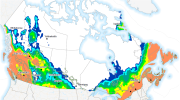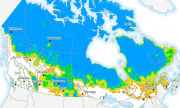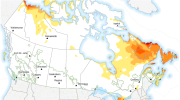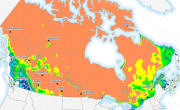Météorologie
Type of resources
Available actions
Keywords
Contact for the resource
Provided by
Years
Representation types
Update frequencies
status
Service types
-

This table contains quality-controlled weather station data from various sources across Canada since 2006.
-
This product is a 1km resolution composite over the North American domain, which, for areas with radar coverage, can distinguish the occurrence, type and intensity of precipitation. This product uses two 1km radar composites as input: a North American composite cleaned using dual polarization technology, another particle classification radar composite (precipitation) and surface temperature from the High Resolution Deterministic Prediction System (HRDPS). The SPTP product is produced every 6 minutes.
-

Probability of the daily precipitation above 2mm over the forecast period (p1d2_prob). Week 1 and week 2 forecasted probability is available daily from September 1 to August 31. Week 3 and week 4 forecasted probability is available weekly (Thursday) from September 1 to August 31. Units: mm Precipitation (moisture availability) establishes the economic yield potential and product quality of field crops. Both dry and wet precipitation extremes have the ability to inhibit proper crop growth. The greatest daily precipitation index covers the risk of excessive precipitation in the short term, while the other indices pertain to longer term moisture availability. Agriculture and Agri-Food Canada (AAFC) and Environment and Climate Change Canada (ECCC) have together developed a suite of extreme agrometeorological indices based on four main categories of weather factors: temperature, precipitation, heat, and wind. The extreme weather indices are intended as short-term prediction tools and generated using ECCC’s medium range forecasts to create a weekly index product on a daily and weekly basis.
-

Frost free days are the number of days in the forecast period with a minimum temperature above the frost temperature; the temperature at which frost damage occurs. This temperature is 0°C for warm season crops (ffd_warm). Week 1 and week 2 forecasted index is available daily from April 1 to October 31. Week 3 and week 4 forecasted index is available weekly (Thursday) from April 1 to October 31. Warm season crops require a relatively warm temperature condition. Typical examples include bean, soybean, corn and sweet potato. They normally grow during the summer season and early fall, then ripen in late fall in southern Canada only. Other agricultural regions in Canada do not always experience sufficiently long growing seasons for these plants to achieve maturity. The optimum temperature for such crops is 30°C. Agriculture and Agri-Food Canada (AAFC) and Environment and Climate Change Canada (ECCC) have together developed a suite of extreme agrometeorological indices based on four main categories of weather factors: temperature, precipitation, heat, and wind. The extreme weather indices are intended as short-term prediction tools and generated using ECCC’s medium range forecasts to create a weekly index product on a daily and weekly basis.
-

Heat Wave Days are the number of days in the forecast period with a maximum temperature above the cardinal maximum temperature, the temperature at which crop growth ceases (dhw_cool). This temperature is 30°C for cool season crops. Week 1 and week 2 forecasted index is available daily from April 1 to October 31. Week 3 and week 4 forecasted index is available weekly (Thursday) from April 1 to October 31. Cool season crops require a relatively low temperature condition. Typical examples include wheat, barley, canola, oat, rye, pea, and potato. They normally grow in late spring and summer, and mature between the end of summer and early fall in the southern agricultural areas of Canada. The optimum temperature for such crops is 25°C. Agriculture and Agri-Food Canada (AAFC) and Environment and Climate Change Canada (ECCC) have together developed a suite of extreme agrometeorological indices based on four main categories of weather factors: temperature, precipitation, heat, and wind. The extreme weather indices are intended as short-term prediction tools and generated using ECCC’s medium range forecasts to create a weekly index product on a daily and weekly basis.
-

The maximum wind speed during the forecast period km/hr (mdws). Week 1 and week 2 forecasted index is available daily from September 1 to August 31. Week 3 and week 4 forecasted index is available weekly (Thursday) from September 1 to August 31. Winds can significantly influence crop growth and yield mainly due to mechanical damage of plant vegetative and reproductive organs, an imbalance of plant-soil-atmosphere water relationships, and pest and disease distributions in agricultural fields. The maximum wind speed and the number of strong wind days over the forecast period represent short term and extended strong wind events respectively. Agriculture and Agri-Food Canada (AAFC) and Environment and Climate Change Canada (ECCC) have together developed a suite of extreme agrometeorological indices based on four main categories of weather factors: temperature, precipitation, heat, and wind. The extreme weather indices are intended as short-term prediction tools and generated using ECCC’s medium range forecasts to create a weekly index product on a daily and weekly basis.
-

The Probability (likelihood) of frost occurring. The number of days in the forecast period with a minimum temperature below the frost temperature, the temperature at which frost damage occurs. This temperature is -2°C for cool season crops (ffd_cool_prob). Week 1 and week 2 forecasted probability is available daily from April 1 to October 31. Week 3 and week 4 forecasted probability is available weekly (Thursday) from April 1 to October 31. Cool season crops require a relatively low temperature condition. Typical examples include wheat, barley, canola, oat, rye, pea, and potato. They normally grow in late spring and summer, and mature between the end of summer and early fall in the southern agricultural areas of Canada. The optimum temperature for such crops is 25°C. Agriculture and Agri-Food Canada (AAFC) and Environment and Climate Change Canada (ECCC) have together developed a suite of extreme agrometeorological indices based on four main categories of weather factors: temperature, precipitation, heat, and wind. The extreme weather indices are intended as short-term prediction tools and generated using ECCC’s medium range forecasts to create a weekly index product on a daily and weekly basis.
-

The Probability (likelihood) of cool wave days for cool season/overwintering crops occurring Cool Wave Days are the number of days in the forecast period with a minimum temperature below the cardinal minimum temperature, the lowest temperature at which crop growth will begin (dcw_cool_prob). This temperature is 5°C for cool season crops. Week 1 and week 2 forecasted probability is available daily from April 1 to October 31. Week 3 and week 4 forecasted probability is available weekly (Thursday) from April 1 to October 31. Cool season crops require a relatively low temperature condition. Typical examples include wheat, barley, canola, oat, rye, pea, and potato. They normally grow in late spring and summer, and mature between the end of summer and early fall in the southern agricultural areas of Canada. The optimum temperature for such crops is 25°C. Agriculture and Agri-Food Canada (AAFC) and Environment and Climate Change Canada (ECCC) have together developed a suite of extreme agrometeorological indices based on four main categories of weather factors: temperature, precipitation, heat, and wind. The extreme weather indices are intended as short-term prediction tools and generated using ECCC’s medium range forecasts to create a weekly index product on a daily and weekly basis.
-

The number of days during the forecast period with an average wind speed greater than 30 km/h (nswd_prob). Week 1 and week 2 forecasted probability is available daily from September 1 to August 31. Week 3 and week 4 forecasted probability is available weekly (Thursday) from September 1 to August 31. Winds can significantly influence crop growth and yield mainly due to mechanical damage of plant vegetative and reproductive organs, an imbalance of plant-soil-atmosphere water relationships, and pest and disease distributions in agricultural fields. The maximum wind speed and the number of strong wind days over the forecast period represent short term and extended strong wind events respectively. Agriculture and Agri-Food Canada (AAFC) and Environment and Climate Change Canada (ECCC) have together developed a suite of extreme agrometeorological indices based on four main categories of weather factors: temperature, precipitation, heat, and wind. The extreme weather indices are intended as short-term prediction tools and generated using ECCC’s medium range forecasts to create a weekly index product on a daily and weekly basis.
-

Frost free days are the number of days in the forecast period with a minimum temperature above the frost temperature; the temperature at which frost damage occurs. This temperature is -2°C for cool season crops (ffd_cool). Week 1 and week 2 forecasted index is available daily from April 1 to October 31. Week 3 and week 4 forecasted index is available weekly (Thursday) from April 1 to October 31. Cool season crops require a relatively low temperature condition. Typical examples include wheat, barley, canola, oat, rye, pea, and potato. They normally grow in late spring and summer, and mature between the end of summer and early fall in the southern agricultural areas of Canada. The optimum temperature for such crops is 25°C. Agriculture and Agri-Food Canada (AAFC) and Environment and Climate Change Canada (ECCC) have together developed a suite of extreme agrometeorological indices based on four main categories of weather factors: temperature, precipitation, heat, and wind. The extreme weather indices are intended as short-term prediction tools and generated using ECCC’s medium range forecasts to create a weekly index product on a daily and weekly basis.
 Arctic SDI catalogue
Arctic SDI catalogue